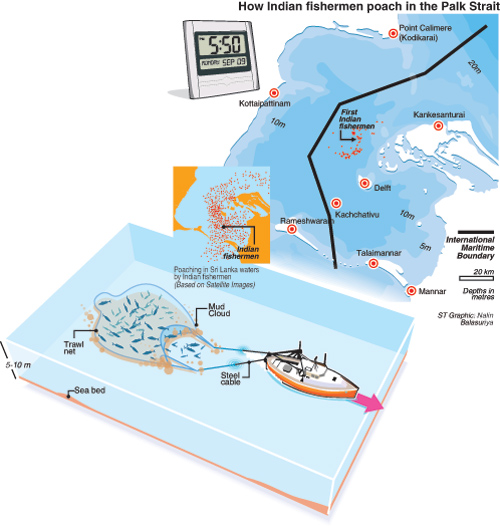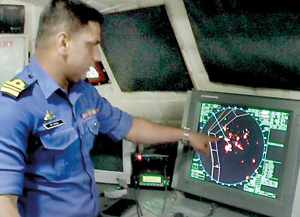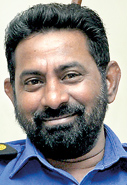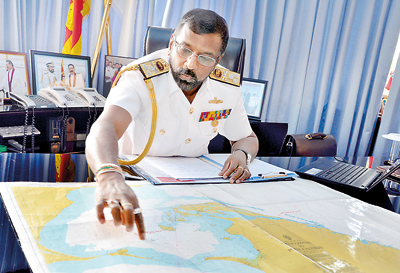News
From a Dvora, we see the rape of our sea
In an island where large rocky coral stones heavily outnumber civilian inhabitants and wild ponies, 56-year-old Illangan Anthonimuthu sat distraught outside his home on the beachfront — a crumbled structure of cement blocks with rusty tin sheets for a roof.

With ‘decrees’ being declared on local fishermen, the northern seas are invaded by Indian boats. Pix by Lakshman Gunathilaka
The frustration of not being able to set out to sea on Monday September 9, as his family had done for generations, reflected in his face. Instead he was tending to a torn net when I met him together with cameraman Lakshman Gunathilaka. “I cannot ply my trade in our own part of the sea today,” the father of four children lamented.
The reason: Tamil Nadu fishermen have “decreed” that their Sri Lankan counterparts should not venture out in Sri Lanka’s own territorial waters on Mondays, Wednesdays and Saturdays. They have chosen those days exclusively for themselves. “There is not much fish left for use when we set out on the remaining days,” Anthonimuthu said echoing the sentiments of those in his tribe. He complained this was because of “bottom trawling” or sweeping the marine rich seabed with nets tied by rope to their speeding trawlers.
“Even the nets cast by Local fishermen with Regi foam floats on their days of fishing are badly torn or swept away denying them even a meagre catch,” he said.

The dichotomy here is even more telling. The Tamil Nadu fishermen use boats with powerful on-board motors that are at least four times larger than the size of motors used by their Sri Lankan counterparts. The Sri Lankans fish in smaller fibreglass flat bottom boats fitted with outboard motors. At any given time local fishermen are overwhelmingly outnumbered.
This unilateral action by the Tamil Nadu fishermen takes place while Colombo and New Delhi are haggling via diplomatic channels to end the menace of poaching. With the issue reaching such high levels of impunity, the Sri Lankan authorities have begun arresting the poachers and producing them before courts. By this week, some 94 Tamil Nadu fishermen are facing court action. Yet, the menace continues.

As we walked the coast of the Island of Delft, where fishing is the livelihood for most of the 1,500 families, the sad tale of the invasion by Tamil Nadu fishermen and the enormous damage they cause hit us. Fishing nets are piled up outside the small homes of the local fishermen. They are forced to follow the “decree.” Anthonimuthu said he and other fishermen, the vast majority of them Catholics, prayed every day that the “intrusion” should end.
Their predicament is not limited to Delft, the only inhabited island not linked by a land route to the Jaffna peninsula. It covers the mainland and other outlying islands too.
“You will get a clearer picture when you move within our International Maritime Boundary Line (IMBL) on the three days in question,” says Captain K.A.P.S.K. Kariyapperuma, Commanding Officer of the SLNS Wasamba based in the Delft Island. The IMBL is the imaginary line that divides Sri Lankan and Indian territorial waters in the Palk Straits. It was early Monday evening and we rush to avoid night fall. After a short ride in an Inshore Patrol Craft (IPC), we transfer at mid sea to SLNS Thilina, a Sri Lanka Navy Dvora Fast Attack Craft (FAC).

Rt. Rev. Thomas Savundranayakam
Moments later, we are at the Bridge, the level two-platform which is the nerve centre. Commanding Officer, Lieutenant Commander D.N.S. Bandara points to the radar screen. On the left side lay a straight line that cuts across diagonally midway to the right. That setting is the IMBL, a reminder to naval craft not to stray into Indian waters.
The time is a few minutes past 5 p.m. on Monday September 9. He points to hundreds of moving dots. Each dot has a tail, a sign that it is not static but moving. It is similar to how one would see tadpoles darting across an algae-filled pond.
“These are all fishing craft from Tamil Nadu,” says Lt. Cmdr. Bandara. The dots had reached even closer to the islands of Eluvaitivu and Analaitivu. “It will take us eight minutes to get to one cluster,” he says and warns us of to be vary of two factors. The seas were turning rough and there was the need to hold tight as his craft cut through the choppy waters.
We climb to the weather deck (open to the sky and exposed to the weather) and hold on to the steel railings. The FAC engine goes into near full throttle. At some 40 knots or a land speed of about 74 kilometres an hour, we move into the theatre of poaching by Tamil Nadu fishermen. It is business as usual for the Navy men on board. The only difference, the canon in the fore and a machine gun in the aft are covered in canvas. The war has ended and the men are not armed. The curtain rises on a bigger drama.

Lt.Commander D.N.S. Bandara points to the yellow blobs on the radar screen that indicate the number of Indian boats poaching in Lankan waters
The presence of the Navy’s FAC causes panic. Those in boats with the tricolour Indian national flag fluttering raise their hands in apparent surrender. At the end of a large boat are two nylon ropes pulling a net that is on the ocean floor. In a few boats, fishermen cross their hands to hold their ears and do dips, much the same way one would in a Kovil in repentance over a folly. The FAC does a few circuits in the choppy seas. Both the naval craft as well as the fishing boats are hit by turbulence. The strong winds blow large moving craters forcing them to rise up and fall. Some of the fishing boats move away. Another Navy FAC turns up in the area and a sailor beckons the fishing craft to leave Sri Lankan waters. Only a few are left tossing in the rough seas and appear not unduly worried about the presence of Navy craft.
“Earlier, the boats of Tamil Nadu fishermen were made of wood. They are now turning them out in steel. Any ramming would thus lead to more damage to the aluminium hull of the FACs,” says Rear Admiral Sarath Dissanayake, Northern Naval Area Commander. Hence CO’s (Commanding Officers) of patrol craft are cautious when they have to apprehend a boat. A modus operandi was for fishing craft to cross the IMBL boundary in swarms, he revealed. During a briefing ahead of our voyage, when we met him at his headquarters, he said, that “around a 1,000 Indian fishing trawlers come every other day.” Inside the jetty of the Northern Naval Area Headquarters at Kankesanthurai lay three-large boats just seized after Indian fishermen were arrested.
During a meeting at the Navy Headquarters in Colombo, Navy, Commander Vice Admiral Jayanath Colombage told the Sunday Times, “There are serious doubts about the legality of bottom trawling. We do not permit it.” He pointed out that the European Union has on occasions accused Sri Lankan fishermen, even issuing a yellow card, for what is called unregulated fishing. In the early stages, he said, there was no “bottom trawling.” It had been introduced by Norwegians providing assistance to the fishing industry in 1974. A Q & A with Vice Admiral Colombage appears in a box story on this page.

Rear Admiral Sarath Dissanayake, Northern Naval Area Commander
“The Indians come in big numbers. They come and destroy the nets of our fishermen,” says Rt. Rev. Thomas Savundranayakam, the Bishop of Jaffna.
His diocese, besides other areas, extends to the outlying islands of the Jaffna peninsula. “Why should they come here? They claim our fishing grounds are richer. Our Navy at times arrests the Indian fishermen or chases them away.
Then they complain of harassment,” he noted. He said the governments of Sri Lanka and India “should do something about this immediately.”
As the FAC SLNS Thilina’s roaring 4175 horsepower engine cut a swathe of white foam seen for kilometres as it sped, the clusters of Tamil Nadu fishing craft had regrouped again for the rape of Sri Lanka’s own marine resources. This time there were lights that came as proof. It was nightfall when we returned to the KKS jetty.
Tamil Nadu pledges to protect its fisher folk
This is what the Tamil Nadu state government’s Fisheries Department ‘Policy Note’ 2013-2014 says in its introduction;
“Fishing activity, starting as a traditional livelihood activity in early fifties has now transformed into commercial enterprise contributing to the State and National economy, livelihood and nutritional security, rural employment generation and foreign exchange earnings significantly.
“Tamil Nadu is one of the foremost States in India showing steady increase in fish production and optimum utilisation of resources. Tamil Nadu is pioneering many innovative developmental and welfare schemes. The fisheries sector faces the challenges of transboundary issues, over exploitation of resources, need for further inputs in ’processing’ infrastructure facilities …..
“The fishermen of Palk Bay districts who drift to the other side of the International Maritime Boundary Line (IMBL), while fishing in Palk Strait area are at times arrested/harassed by the Sri Lanka Navy… .. … fishermen who conduct fishing in their traditional areas of Palk Bay region to earn their livelihood are periodically arrested or harassed by the Sri Lanka Navy.
“The Government is committed to protecting the traditional fishing rights of Tamil Nadu fishermen”.
Livelihood of our fisher folk drowning: Navy Chief
At his headquarters in Colombo, Navy Commander Vice Admiral Jayanath Colombage spoke exclusively to the Sunday Times on poaching by Tamil Nadu fishermen. Here are edited excerpts:
ON “BOTTOM TRAWLING”:

Navy Commander Vice Admiral Jayanath Colombage
A net is cast on the ocean floor and trawling takes place. It scrapes the bottom. Even small prawns are caught. Cuttlefish, sea cucumber, crabs, rock fish are also caught. The coral bed is damaged. It scrapes about 10 cm of the surface. In the process the marine environment is destroyed. Since the water is disturbed and the turbidity is high, the sun light does not penetrate and as a result sea grass does not grow.
A Tamil Nadu fishing trawler catches about 200 kilograms of the fish a day. There about 1,000 such fishing trawlers indulge in poaching. Though they catch about 200 kilograms, about 25 or 30 per cent of this which includes small fish is thrown overboard.
The Indian Navy and the Indian coast guards are aware that the Indian fishermen cross the IMBL, but they do not take action against them. We try to push them back and if they come closer we arrest some of them.
AREAS OF POACHING IN SRI LANKAN WATERS:
It takes place not only in the north but in areas in the North West including Iranativu, Kalpitiya, Bathalangunduwa, Silavathurai and in the north eastern Pulmoddai seas.
THE ‘EXCUSE’ GIVEN BY INDIAN FISHERMEN WHO ARE CAUGHT:
When we arrest the Indian fishermen, they claim they have drifted into Sri Lankan waters. This cannot be accepted. They have GPS (Global Positioning System) and also voice communication. The fishermen are also clever at identifying the distance based on the lights they see.
PROBLEMS OF SRI LANKAN FISHERMEN:
One of the problems that our fishermen face is that their fishing nets get cut due to methods used by the Indian boats. Our boats are smaller in size. One of the biggest problems is that the Indian boats are strong; the hull is made of steel.
It is an issue of the livelihood of our fishermen. Local fishermen are agitating over this. Some of the local fishermen try to take the issue into their hands. During the conflict there were restrictions placed on our fishermen. We have now lifted these restrictions.
NAVY’S PURSUITS:
Our patrol craft try and chase them away. We also flash lights warning them to keep away. This year, we have arrested 41 Indian fishing boats and 263 fishermen. Currently 145 Indian fishermen are in custody.
We arrest some of the fishermen and hand them over to the Police and they go through the legal process. They are charged with violating the IMBL. The Tamil Nadu government claims we are harassing the Indian fishermen. That is wrong. We do not harass them. The attacks on our pilgrims and stopping the military training are all by-products of the fishing issue.
The joint Working Group has not met for a long time. Through our High Commissions the negotiations take place. Poaching is one issue. Environmental pollution is another. Sharing of information, the possibility of using this area for drug smuggling and human smuggling is another issue. Training Communication procedures are also discussed. The IMBL meeting is Navy to Navy and Coast Guard to Coast Guard.
Indian ships know that we don’t cross into their waters.
comments powered by Disqus
